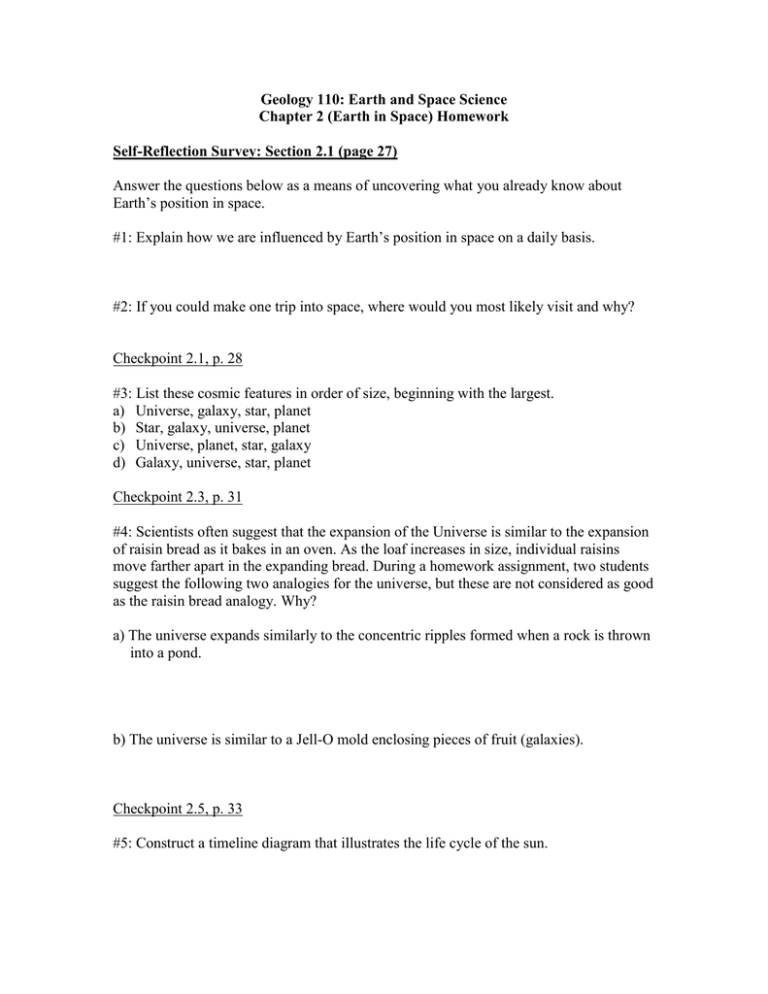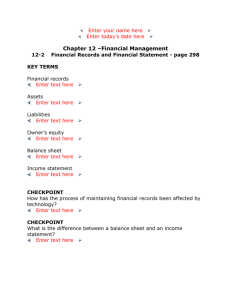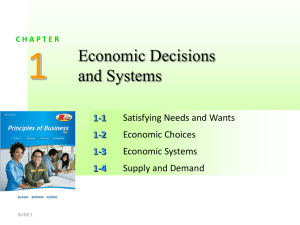Geology 110: Earth and Space Science
advertisement

Geology 110: Earth and Space Science Chapter 2 (Earth in Space) Homework Self-Reflection Survey: Section 2.1 (page 27) Answer the questions below as a means of uncovering what you already know about Earth’s position in space. #1: Explain how we are influenced by Earth’s position in space on a daily basis. #2: If you could make one trip into space, where would you most likely visit and why? Checkpoint 2.1, p. 28 #3: List these cosmic features in order of size, beginning with the largest. a) Universe, galaxy, star, planet b) Star, galaxy, universe, planet c) Universe, planet, star, galaxy d) Galaxy, universe, star, planet Checkpoint 2.3, p. 31 #4: Scientists often suggest that the expansion of the Universe is similar to the expansion of raisin bread as it bakes in an oven. As the loaf increases in size, individual raisins move farther apart in the expanding bread. During a homework assignment, two students suggest the following two analogies for the universe, but these are not considered as good as the raisin bread analogy. Why? a) The universe expands similarly to the concentric ripples formed when a rock is thrown into a pond. b) The universe is similar to a Jell-O mold enclosing pieces of fruit (galaxies). Checkpoint 2.5, p. 33 #5: Construct a timeline diagram that illustrates the life cycle of the sun. Checkpoint 2.9, p. 34 #6: What are the principal components of the sun? (Hint: See previous section.) a) Hydrogen and helium b) Carbon and oxygen c) Silicon and sodium d) Nickel and iron Checkpoint 2.10, p. 34 #7: Sunspots, flares, and other emissions from the sun’s surface can have a negative impact on electrical systems on Earth. What would be the implications for this type of solar activity if the sun did not experience differential rotation? a) There would be less sun spot activity. b) There would be more sun spot activity. c) There would be no change in sun spot activity. Checkpoint 2.13, p. 38 #8: Which of the following sequences of planets is out of order? a) Mars, Jupiter, Saturn, Uranus, Neptune b) Venus, Mars, Earth, Jupiter, Saturn c) Neptune, Uranus, Saturn, Jupiter, Mars d) Jupiter, Mars, Earth, Venus, Mercury Checkpoint 2.14, p. 38 #9: Make four generalizations about the 8 planets in our solar system using the information in Table 2.1. For example, planets closer to the sun are smaller than those farther away. (but don’t use this one)! Also, make sure to generalize about all of the planets for each comparison. Four generalizations: 1. 2. 3. 4. Checkpoint 2.17, p. 44 #10: How do we define the length of a year on Earth? a) A year is related to the revolution of Earth around the sun. b) A year is related to the rotation of Earth on its axis. c) A year is related to the rotation of the sun on its axis. d) A year is related to the revolution of the sun around Earth. Checkpoint 2.20, p. 44 #11: Imagine that it is your job to explain to a group of middle school students how the distribution of incoming solar radiation varies daily and seasonally on Earth’s surface. Assuming you have a basketball and flashlight to use as props, write a description of how you would have the students use the props in a demonstration. Checkpoint 2.21, p. 45 #12: What are the three compositional layers in the Earth’s interior? a) Asthenosphere, lithosphere, core b) Oceanic crust, continental crust, asthenosphere c) Lithosphere, mantle, core d) crust, mantle, core Checkpoint 2.24, p. 47 #13: Complete the following concept map by writing the correct terms in the appropriate blank locations as key terms or connecting phrases/terms. A partial list of terms that you will need is provided here, but some of them may not be applicable to this diagram. 1. Compositional layers 2. Crust 3. One of three 4. Oceans 5. Is the source of Earth’s 6. An upper rigid 7. Characteristic of terrestrial planet Checkpoint 2.25, p. 50: Defining Earth’s Characteristics #14: Read the sentences in the following table and place an X next to the appropriate term in the right-hand columns that could be used to complete the sentence or fill in the blank. Explain the reason for your choices. If Earth was farther from the sun the planet would be ___. warmer colder If Earth was a little closer to the sun the oceans would be ___. smaller larger If Earth did not have a biosphere, the composition of Earth’s atmosphere would be ___. the same different If Earth’s biosphere were younger we would have _______ oxygen in the atmosphere. less more If Earth did not have an atmosphere its surface would have _______ craters formed by meteorite impacts less more If Earth did not have an atmosphere, life on the land surface would be ________ developed than it is today. less more If Earth were larger its gravity would be ________. weaker stronger If Earth were smaller its atmosphere would be _________. thicker thinner If Earth were smaller it would have a ________ interior. hotter colder





